Explore The Sacred Jui Tui Shrine In Phuket Which Is A Centre Of Religion And Culture
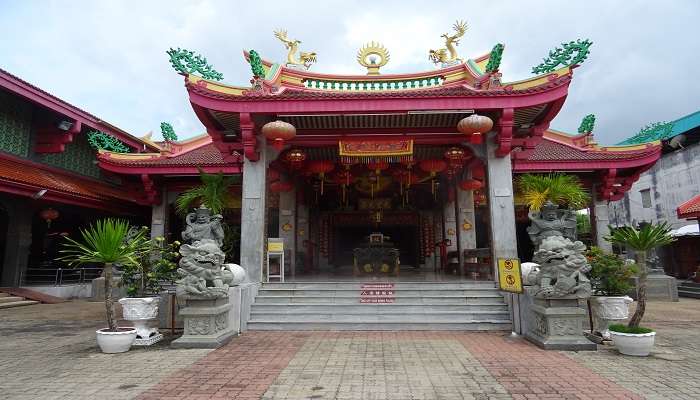
Located in the old town of Phuket, the Jui Tui shrine is a vibrant Chinese temple and cultural heritage. Being one of the oldest Chinese temples on the island, it is a hot spot for cultural and traditional activities. The temple offers a glimpse into the rich culture and religion of the Chinese people. The temple, with its vibrant hues, attracts tourists from all over the world. The temple is also the centre for the Phuket vegetarian festival, a famous festival celebrating 9 Chinese gods in 9 days and bringing together the people of Phuket for elaborate rituals.
Jui Tui Shrine History
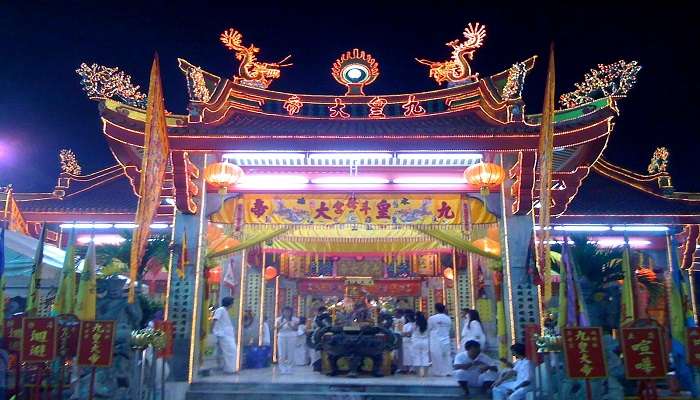
Jui Tui shrine is one of the oldest Chinese temples dedicated to Tean Hu Huan Soy, the Chinese god of dance and arts. The original Jui Tui shrine was located at Sai Romanee in Phuket but it was burned down by a fire. It was re-established at its current location at Ranong Road in the centre of Phuket.
Jui Tui Shrine Phuket was established by a Chinese worker in Thailand. According to their belief, the god Tean Hu Huan Soy brings good fortune and provides protection. The shrine is the focal point for rituals, fire walking, and traditions during the annual Phuket Vegetarian Festival. It plays an important role and stands as a testament to the time and faith of the Chinese population.
Must Read: Thailand Temples
Jui Tui Shrine Architecture

The original Jui Tui shrine was built in 1911 on land donated by a gardener. It was reconstructed in 1982 by the Chinese and the Thai people creating a beautiful tapestry of both cultures. Jui Tui Shrine is a unique blend of Thai and Chinese architecture that attracts visitors worldwide. It has ornate rooflines that are decorated with vibrant colours, dragons, and intricate woodwork. The entrance of the temple is beautified with two lion statues made of marble on each side. The colour combination of red and golden paints a vibrant picture and is believed to bring good luck and prosperity.
As you enter the temple, the main hallways are adorned with several Taoist deities. Devotees come from far and wide to pray and seek blessings from the Chinese gods. The main temple is beautified with Chinese motifs, dragon lanterns, and an aroma of incense sticks all around.
Suggested Read: Resorts In Vung Tau
Highlights Of Jui Tui Shrine Phuket
Jui Tui shrine in Phuket is always brimming with visitors and devotees offering prayers. In this vibrant temple, you would see multiple buildings. Here is what you should do as you enter the Jui Tui shrine:
1. The Main Pagoda
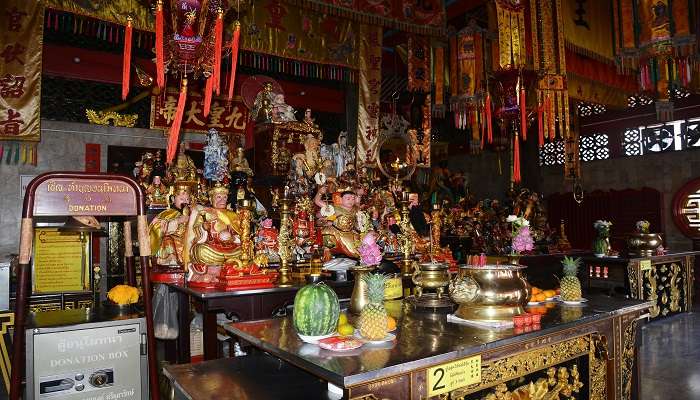
The first thing you will see upon entering the temple is the Main Pagoda, a historic, vibrant, red-coloured building adorned with detailed carvings reflecting traditional Chinese influences. Visitors often come to the main pagoda to light incense and pray for blessings. The serene ambience and rich cultural heritage make the main pagoda a central highlight of the Jui Tui Shrine, offering a peaceful retreat amidst the bustling city.
Suggested Read: Thien Hau Temple
2. Hu Huan Soy
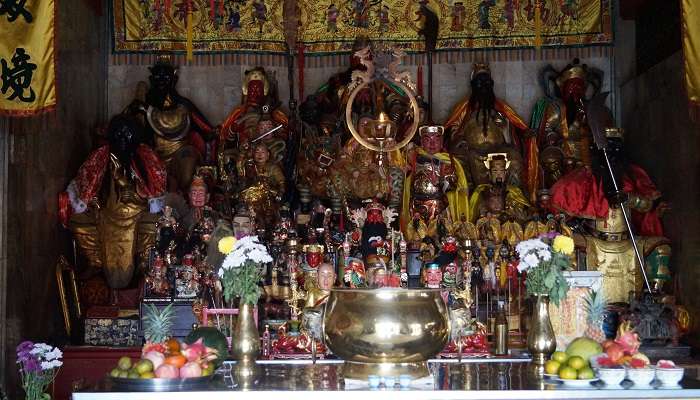
The centre stage of the main temple area houses the God Tean Hu Huan Soy, the god of performing arts and dance. The idol is surrounded by a hen and dog beside it, as they were his favourite animals as a child. Local devotees often perform dance shows as a tribute to the god. Tean Hu Huan Soy is believed to bless devotees with creativity, talent, and success in artistic endeavours.
3. The Firecracker House
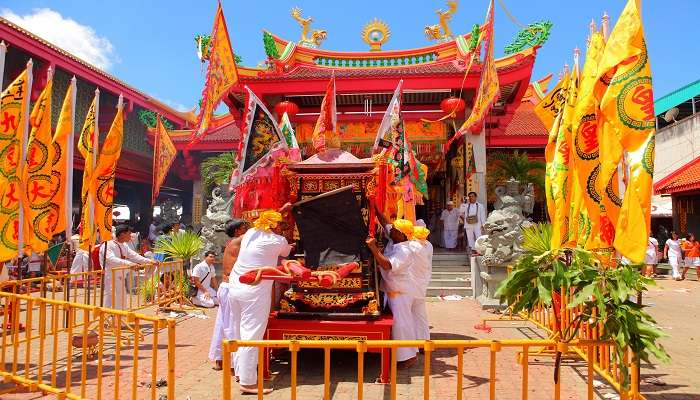
After a visit to the Main Pagoda, you will see a tall and colourful building as you turn to the left. The building was established in 2011 in honour of completing 100 years of the Jui Tui shrine. The building is used to launch firecrackers on special occasions and festivals.
Suggested Read: Things To Do In Phuket
4. Fortune Sticks
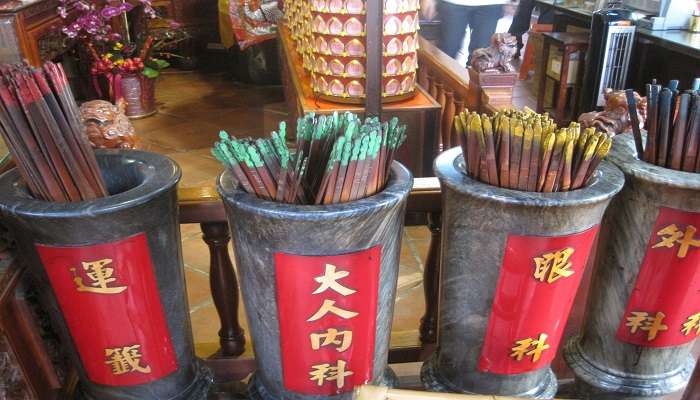
Jui Tui is popular for its fortune-telling in Thailand. In the prayer hall, you can take and shake a bamboo cup. The cups contain a designated stick number; you must stop as one stick falls out. If more than one stick fell out, you must repeat the thing. The stick number that falls outmatches the number on the fortune paper, which is available in the red cabinet. The writings in the paper are in Thai or Chinese so you will have to ask a monk to read and explain it to you.
Best Time To Visit Jui Tui Shrine Phuket

Phuket mainly has two seasons: dry and wet. The best time to visit is in the cooler months of December to March, with temperatures ranging from 23 degrees to 30 degrees Celsius. Phuket does not experience cold winters; hence, you can enjoy all water sports this season. This is also the peak season; everything would be available at a higher price. Enjoy the low humidity, clear skies, and windy days of this season in Phuket.
You can also visit Phuket in the other months if you want to explore Phuket with a smaller crowd. The temperature from March to May is around 30 to 40 degrees Celsius, making it unfavourable for enjoying outdoor activities.
You may visit in the monsoon period from June to October and experience the trip at a
lower cost but with sudden light rainfall showers. In the monsoon, the temperature is around 26 to 34 degrees Celsius. Also, you can witness the Phuket vegetarian festival, which takes place from September to October, depending on the Chinese calendar. It is a nine-day festival and attracts tourists from all over the world. It is the best time to experience the culture and enjoy the festival of Phuket.
Suggested Read: Shopping In Thailand
How To Reach Jui Tui Shrine Phuket
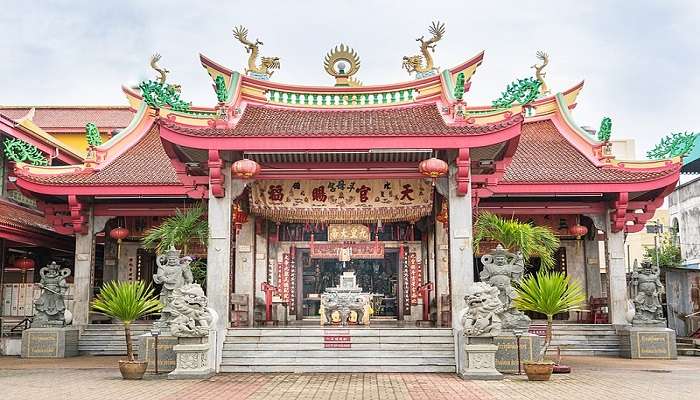
Jui Tui shrine is located on the Ranong Road in the heart of Phuket. Visitors can easily access the temple with multiple transport options as listed below:
By Taxi: You can take a taxi from the Phuket International Airport, which is 30 km away from the temple. Depending on the traffic conditions, it should take around 30 to 40 minutes to reach the temple.
By Tuk-Tuk: You can head out to the shrine by tuk-tuk. Make sure to bargain the rates effectively to get the honest rate.
By Local Buses: You can take a bus from any of the islands near Phuket. Local buses in Phuket are known as Sonthaews and are available at pocket-friendly rates.
Jui Tui Shrine Phuket: Interesting Things To Do
If you are done taking a tour of the Jui Tui shrine and have more time in hand, then you must explore the charm of the Phuket Old Town. Al located at a short distance, you can go either by walking or on a short tuk-tuk ride. Explore the culture and lifestyle of the Thai people as you navigate through these places:
1. Explore Museums Of Phuket
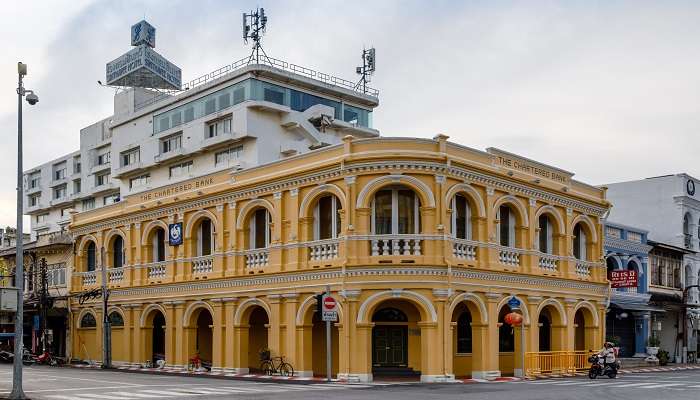
Phuket is home to many historic museums, which will give you a sneak peek into the island’s rich history. To get a deeper understanding of Phuket’s evolution and culture, visit popular museums such as Thai Hua Museum, Phuket Baba Museum, Phuket Philatelic Museum, and Thavorn Museum. Each museum provides a unique perspective, making them essential stops for history buffs and curious travellers alike.
Suggested Read: Best Resorts In Ninh Binh
2. Enjoy Shopping In Phuket

The town of Phuket is filled with rich architecture, exquisite cuisine and an elaborate market. Being a shopper’s haven, you will find an array of items from old antiquities to bouquets to royal furniture being sold at a much cheaper rate than anywhere else. Take a look at the regional handicrafts and jewellery as they are a speciality of the Thai market. You can visit the Thailand market in Soi Romanee and Phuket’s weekend market to explore the shopping experience among the Thai people.
3. Savour Local Delicacies

Phuket’s culinary scene is a rich blend of Thai and Peranakan flavours, offering a delightful experience for food lovers. Must-try dishes include Tom Yam Goong, a spicy and aromatic shrimp soup, and Pad Thai, a classic stir-fried noodle dish that balances savoury and sweet flavours. Hokkien Mee, a local speciality of stir-fried yellow noodles with seafood and pork, showcases the island’s Chinese heritage. Dim Sum is widely available and popular for breakfast or brunch. Don’t miss Kanom Jeen Phuket, a dish of thin rice noodles served with various curries and fresh vegetables, offering a true taste of local cuisine.
Further Read: Beaches In Phuket
Jui Tui shrine offers a view into the cultural and religious life of the Thai and Chinese people. With its exquisite architecture and serene atmosphere, you will feel relaxed as you tour the temple. The temple is a testament to the devotion and faith of the Chinese people. Hear the stories of the main deity in the temple from the monks and priests. If this guide about Jui Tui shrine motivated you, then here are some of the best packages for a trip to Phuket . Connect with your spiritual side and find inner peace as you walk through the alleys of the Jui Tui shrine.
For our editorial codes of conduct and copyright disclaimer, please click here.
Cover Image Credit: Christophe95 for Wikimedia Commons
Frequently Asked Questions About Jui Tui Shrine
How much time is required in the Jui Tui temple?
Around 2 to 3 hours are required for a complete tour of Jui Tui highlights soak in the refreshing ambience of the temple and feel rejuvenated.
What should I wear in the Jui Tui temple?
It is important to dress modestly and cover your knees as this is a holy site. Avoid dresses that are too revealing and also remember to remove your shoes by the temple entrance.
What are the visiting hours of the Jui Tui shrine?
The temple remains open from 8 AM to 8:30 PM on all days of the year. The temple draws millions of tourists from all over the world because of its colourful architecture and peaceful atmosphere.
Which are the most visited shopping places in Phuket?
Here are the top 5 places you must visit for shopping: Mai Khao, Bantao Beach, Weekend Market, Chillva Market Central Festival and Kamala shopping.
Where is Jui Tui Temple located?
The temple is located in Phuket Town on Soi Phuthorn Road and is a significant worship place, particularly during the annual Phuket Vegetarian Festival.
People Also Read:
Ambalapuzha Temple Akkaraipatti Sai Baba Temple Thien Hau Temple

With a passion for exploring and travelling to the roads long forgotten, experience the world through enthralling stories and adventures. Join me as I share my experiences at some of the world’s most popular tourist destinations and quench that pestering curiosity with something exciting!











